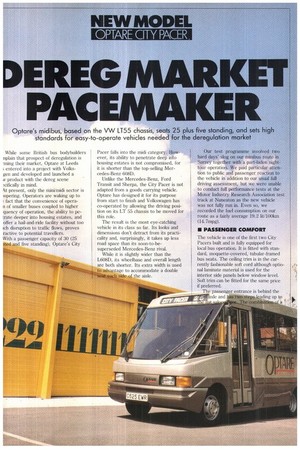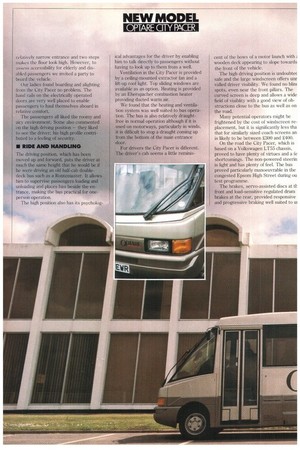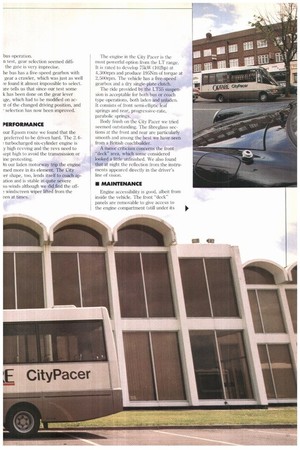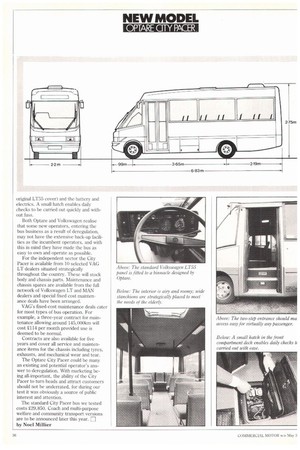G IVIARKET PACEMAKER
Page 53

Page 54

Page 55

Page 56

If you've noticed an error in this article please click here to report it so we can fix it.
Optare's midibus, based on the VW LT55 chassis, seats 25 plus five standing, and sets high standards for easy-to-operate vehicles needed for the deregulation market While some British bus bodybuilders nplain that prospect of deregulation is -ming their market, Optare at Leeds ; entered into a project with Volksgen and developed and launched a N product with the dereg scene cifically in mind.
At present, only the Mini/midi sector is ispering. Operators are waking up to fact that the convenience of operan of smaller buses coupled to higher quency of operation, the ability to petrate deeper into housing estates, and offer a hail-and-ride facility without too ich disruption to traffic flows, proves ractive to potential travellers.
With a passenger capacity of 30 (25 d five standing), Optare's City Pacer falls into the midi category. However, its ability to penetrate deep into housing estates is not compromised, for it is shorter than the top-selling Mercedes-Benz 608D.
Unlike the Mercedes-Benz, Ford Transit and Sherpa, the City Pacer is not adapted from a goods carrying vehicle. Optare has designed it for its purpose from start to finish and Volkswagen has co-operated by allowing the driving position on its LT 55 chassis to be moved for this role.
The result is the most eye-catching vehicle in its class so far. Its looks and dimensions don't detract from its practicality and, surprisingly, it takes up less road space than its soon-to-besuperseded Mercedes-Benz rival.
While it is slightly wider than the 1.608D, its wheelbase and overall length are both shorter. Its extra width is used to advantage to accommodate a double side of the aisle. Our test programme involved two hard days' slog on our minibus route in Surrey together with a part-laden nighttour operation. We paid particular attention to public and passenger reaction to the vehicle in addition to our usual full driving assessment, but we were unable to conduct full performance tests at the Motor Industry Research Association test track at Nuneaton as the new vehicle was not fully run in. Even so, we recorded the fuel consumption on our route as a fairly average 19.2 litilOOkm (14. 7mpg).
RI PASSENGER COMFORT The vehicle is one of the first two City Pacers built and is fully equipped for Local bus operation. It is fitted with standard, moquette-covered, tubular-framed bus seats. The ceiling trim is in the currently fashionable soft cord although optional laminate material is used for the interior side panels below window level Soft trim can be fitted for the same price if preferred.
The passenger entrance is behind the axle and ding up to relatively narrow entrance and two steps makes the floor look high. However, to assess accessibility for elderly and disabled passengers we invited a party to board the vehicle.
Our ladies found boarding and alighting Iron the City Pacer no problem. The hand rails on the electrically operated doors are very well placed to enable passengers to haul themselves aboard in relative comfort.
The passengers all liked the roomy and airy environment. Some also commented on the high driving position — they liked to see Liie driver; his high profile contributed to a feeling of security.
• RIDE AND HANDLING
The driving position, which has been moved up and forward, puts the driver at much the same height that he would be if he were driving an old half-cab doubledeck bus such as a Routemaster. it allows him to supervise passengers loading and unloading and places him beside the entrance, making the bus practical for oneperson operation.
The high position also has its psycholog ical advantages for the driver by enabling him to talk directly to passengers without having to look up to them from a well.
Ventilation in the City Pacer is provided by a ceiling-mounted extractor fan and a lift-up roof light. Top sliding windows are available as an option. Heating is provided by an Eherspacher combustion heater providing ducted warm air.
We found that the heating and ventilation system was well suited to bus operation. The bus is also relatively draughtfree in normal operation although if it is used on motorways, particularly in winds, .it is difficult to stop a draught coming up from the bottom of the main entrance door.
For drivers the City Pacer is different. The driver's cab seems a little reminis
cent of the bows of a motor launch with ; wooden deck appearing to slope towards the front of the vehicle.
The high driving position is undoubtet safe and the large windscreen offers unr valled driver visibility. We found no blir spots, even near the front pillars. The curved screen is deep and allows a wide field of visiblity with a good view of obstructions close to the bus as well as al the road.
Many potential operators might be frightened by the cost of windscreen re placement, but it is significantly less th; that for similarly sized coach screens am is likely to be between £300 and .2400.
On the road the City Pacer, which is based on a Volkswagen LT55 chassis, proved to have plenty of virtues and a shortcomings. The non-powered steerin is light and has plenty of feel. The bus proved particularly manoeuvrable in the congested Epsom High Street during °I test programme.
The brakes, servo-assisted discs at a front and load-sensitive regulated drum brakes at the rear, provided responsive and progressive braking well suited to t bus operation.
n test, gear selection seemed diffithe gate is very imprecise.
he bus has a five-speed gearbox with gear a crawler, which was just as well le found it almost impossible to select are tells us that since our test some k has been done on the gear lever ige, which had to be modified on acit of the changed driving position, and selection has now been improved.
PERFORMANCE
our Epsom route we found that the preferred to be driven hard. The 2.4: turbocharged six-cylinder engine is ly high revving and the revs need to ‘ept high to avoid the transmission or inc protesting.
/n our laden motorway trip the engine med more in its element. The City :er shape, too, lends itself to coach apation and is stable in quite severe ss-winds although we did: find the offwindscreen wiper lifted from the een at times. The engine in the City Pacer is the most powerful option from the LT range. It is rated to develop 751641 (102hp) at 4,300rpm and produce 195Nm of torque at 2,500rpm. The vehicle has a five-speed gearbox and a dry single-plate clutch.
The ride provided by the LI55 suspension is acceptable for both bus or coach type operations, both laden and unladen. IL consists of front semi-elliptic leaf springs and rear, progressive-rate, parabolic springs.
Body finish on the City Pacer we tried seemed outstanding. The fibreglass sections at the front and rear are particularly smooth and among the best we have seen from a British coachbuilder.
A minor criticism concerns the front "deck" area, which some considered looked a little unfinished. We also found that at night the reflection from the instruments appeared directly in the driver's line of vision.
• MAINTENANCE
Engine accessibility is good, albeit from inside the vehicle. The front "deck" panels are removable to give access to the engine compartment (still under its original LT55 cover) and the battery and electrics. A small hatch enables daily checks to be carried out quickly and without fuss.
Both Optare and Volkswagen realise that some new operators, entering the bus business as a result of deregulation, may not have the extensive back-up facilities as the incumbent operators, and with this in mind they have made the bus as easy to own and operate as possible.
For the independent sector the City Pacer is available from 10 selected VAG LT dealers situated strategically throughout the country. These will stock body and chassis parts. Maintenance and chassis spares are available from the full network of Volkswagen LT and MAN dealers and special fixed cost maintenance deals have been arranged.
VAG's fixed-cost maintenance deals cater for most types of bus operation. For example, a three-year contract for maintenance allowing around 145,000km will cost £114 per month provided use is deemed to be normal.
Contracts are also available for five years and cover all service and maintenance items for the chassis including tyres, exhausts, and mechanical wear and tear.
The Optare City Pacer could be many an existing and potential operator's answer to deregulation. With marketing being all-important, the ability of the City Pacer to turn heads and attract customers should not be underrated, for during our test it was obviously a source of public interest and attention.
The standard City Pacer bus we tested costs £29,850. Coach and multi-purpose welfare and community transport versions are to be announced later this year. El by Noel Millier




















































































